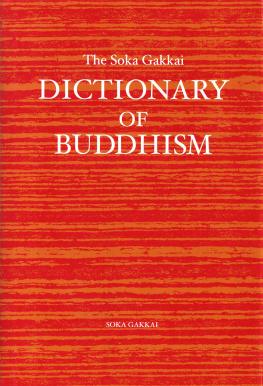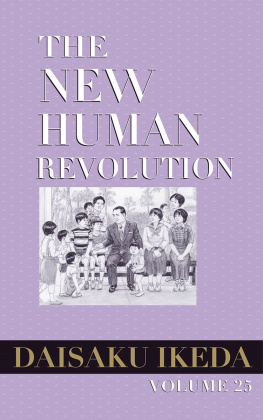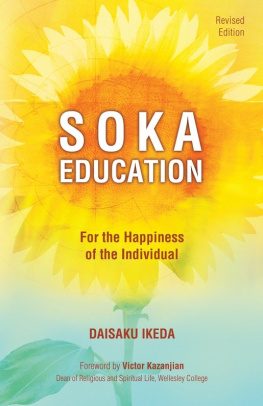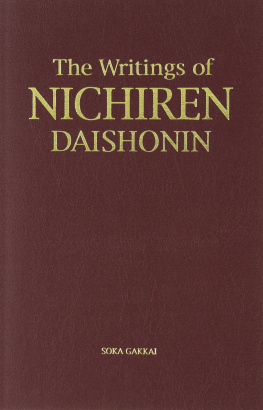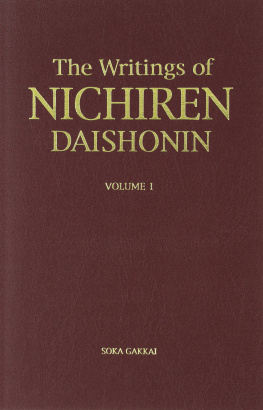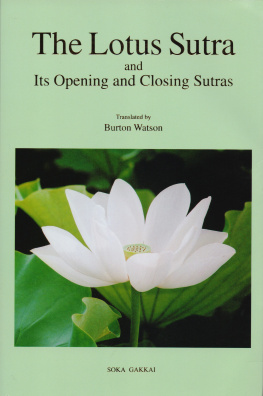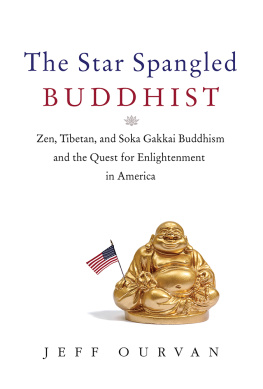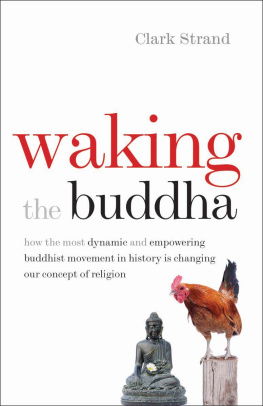Soka Gakkai - The Soka Gakkai Dictionary of Buddhism
Here you can read online Soka Gakkai - The Soka Gakkai Dictionary of Buddhism full text of the book (entire story) in english for free. Download pdf and epub, get meaning, cover and reviews about this ebook. year: 2002, publisher: Soka Gakkai, genre: Religion. Description of the work, (preface) as well as reviews are available. Best literature library LitArk.com created for fans of good reading and offers a wide selection of genres:
Romance novel
Science fiction
Adventure
Detective
Science
History
Home and family
Prose
Art
Politics
Computer
Non-fiction
Religion
Business
Children
Humor
Choose a favorite category and find really read worthwhile books. Enjoy immersion in the world of imagination, feel the emotions of the characters or learn something new for yourself, make an fascinating discovery.
- Book:The Soka Gakkai Dictionary of Buddhism
- Author:
- Publisher:Soka Gakkai
- Genre:
- Year:2002
- Rating:5 / 5
- Favourites:Add to favourites
- Your mark:
- 100
- 1
- 2
- 3
- 4
- 5
The Soka Gakkai Dictionary of Buddhism: summary, description and annotation
We offer to read an annotation, description, summary or preface (depends on what the author of the book "The Soka Gakkai Dictionary of Buddhism" wrote himself). If you haven't found the necessary information about the book — write in the comments, we will try to find it.
The Soka Gakkai Dictionary of Buddhism — read online for free the complete book (whole text) full work
Below is the text of the book, divided by pages. System saving the place of the last page read, allows you to conveniently read the book "The Soka Gakkai Dictionary of Buddhism" online for free, without having to search again every time where you left off. Put a bookmark, and you can go to the page where you finished reading at any time.
Font size:
Interval:
Bookmark:
Soka Gakkai
2002
Fifty years ago, in 1952, the Soka Gakkai published the Nichiren Daishonin gosho zensh (The Complete Works of Nichiren Daishonin). The publication project was initiated and supervised by Jsei Toda, the second president of the Soka Gakkai. On the fiftieth anniversary of that important event, it is my pleasure to witness the publication of a new English dictionary of Buddhist terms, The Soka Gakkai Dictionary of Buddhism .
Since the publication of the Soka Gakkai edition of Nichirens writings, their translation into various languages has been progressing steadily. In the fall of 1999, the Soka Gakkai published The Writings of Nichiren Daishonin, which contains English translations of fully half the writings in the Japanese edition, and those translations have been enthusiastically welcomed by persons interested in Nichiren Buddhism.
The members of the Soka Gakkai practice Nichiren Buddhism, which is based on the Lotus Sutra, a text embodying the essence of Mahayana Buddhism. Nichiren Buddhism has inherited the idea expressed in the sutra that all people are capable of achieving Buddhahood, and the great vow of the Buddha to enable all people to do so. The aim of Nichiren Buddhism is to realize that great vow in our present age, the Latter Day of the Law.
This new dictionary focuses largely on Nichiren Buddhism. But it is my conviction that by studying Nichiren Buddhism, one can familiarize oneself with the core of Mahayana Buddhist thought, which expresses the central teaching of the Buddha aimed at enabling everyone to attain enlightenment.
The Buddhist idea that everyone possesses the Buddha nature, or the potential for enlightenment, expresses a spirit of profound respect for human beings and leads naturally to a philosophy that deeply treasures life. This in turn can provide a spiritual and philosophical basis for dealing with such modern global issues as the protection of human rights, the preservation of the environment, and the attainment of world peace. In this sense, I believe it is extremely important to understand such Buddhist concepts and consider them in terms of their modern significance.
Mahayana Buddhism originated in India, and in the long process of its transmission to new lands with different cultures, it has evolved into a world religion. We are able to discern the beginnings of Mahayana within the Buddhism of India, but it began to flower and bear fruit in earnest as it encountered and spread among different cultures.
Within this universal religion called Mahayana Buddhism there are some ideas that appear to be contrasting or contradictory. The Lotus Sutra, however, sets forth principles that resolve and integrate those apparent contradictions. In addition, it contains a living system of thought and a spiritual tradition that clearly transmit the essence of Buddhism.
For example, regarding the method or way to achieve enlightenment, Buddhist tradition speaks of two contrasting approaches: the power of self and the power of another. The school of Buddhism known as Pure Land attributes salvation to the power of another, that is, to the saving grace of Amida Buddha, while Zen Buddhism advocates salvation through the power of self, or the discipline of seated meditation.
Each of those views offers a partial perspective and, taken by itself, may be considered biased or one-sided. Through the unifying principle expressed in the Lotus Sutra, however, those contrasting views are integrated and resolved, giving rise to the concept of the fusion of self and other. In short, salvation or enlightenment in Buddhism is best achieved by bringing forth the powers of the Buddha and the Law (the power of another) through the power of ones own faith and practice (the power of self).
In another example, from a psychological perspective, earthly desires, which Buddhism regards as the cause of suffering, stand in stark contrast to bodhi, or the enlightenment of the Buddha. That is why early Buddhism taught that enlightenment can only be gained by extinguishing earthly desires.
Mahayana Buddhism, however, ultimately views enlightenment and desire as inseparable, in a relationship described as two but not two. It treats them as mutually inclusive aspects of the same reality. Though one may speak of desires and illusions, they originate from the essential nature of life itself, or the Dharma nature, and in that sense are no different from enlightenment.
The Great Teacher Tien-tai, in his work Great Concentration and Insight, states: The foolish illusions of ignorance originate in the essential nature of phenomena. Because of the influence of delusions, the essential nature of phenomena changes into ignorance. This expresses the principle of non-duality described in the phrase earthly desires are none other than enlightenment. The meaning of this principle is that, though one does not extinguish ones desires and illusions, by developing the wisdom of enlightenment, one is no longer tormented by them; that is, desires and illusions cease to function as negative influences in ones life.
The resolution of contending viewpoints in the above examples also suggests that, when we view things from the perspective of Buddhist wisdom, it is possible to transform the division and contention of todays world into harmony and cooperation.
Naturally, human beings themselves are essential to this process. This is because the various contradictions we see in society and the world ultimately boil down to contradictions within the human being. Buddhism aims to shed light on and thoroughly examine the complex inner realm of the human being and thereby provide a broad and comprehensive overview of life itself.
When we assess things from this holistic perspective, it becomes evident that even life and death are actually not two; that is, they are one in their essential nature.
How do we keep ourselves at peace with and transcend the problem of death, our unavoidable destiny as human beings? In a speech I delivered in 1993 at Harvard University, I spoke of the Mahayana Buddhist view of life and death, and its aim to enable us to know a deep and abiding joy in death as well as life.
Once we are born into the world, none of us can escape death. To address and resolve the problems and suffering associated with life and death, living and dying, is perhaps the most important problem facing humanity in the twenty-first century.
Buddhism elucidates the essential equality present on the level of life itself. It enables people to make the most of their unique natures and qualities, just as cherry, plum, peach, and apricot blossoms, to cite a familiar Buddhist metaphor, each display unique color and fragrance. The aim of Buddhism is to enable people to bring forth and display the innate and enduring power of life itself, to remain unbent and unbowed by any hardship or opposition, and to fully enjoy a condition of absolute happinessenduring happiness that emerges from within and is not dependent on externals. It is a philosophy of life reformation by which one can completely transform tragedy, even death, into profound joy based on an eternal view of life.
Buddhism places strong emphasis on the human heart and mind. We can summarize its message as follows: If peoples hearts and minds change, everything changes. It is the perspective of Buddhism that both conflict and peace arise from the human mind. Mind, however, is not limited to mere process of thought.
An early Buddhist text known as the Dhammapada reads: Hard it is to train the mind, which goes where it likes and does what it wants. But a trained mind brings health and happiness. And the same text states: For hatred can never put an end to hatred; love alone can. This is an unalterable law ( Dhammapada, 3.35 and 1.5, trans. by Eknath Easwaran, Penguin Books, 1987).
Font size:
Interval:
Bookmark:
Similar books «The Soka Gakkai Dictionary of Buddhism»
Look at similar books to The Soka Gakkai Dictionary of Buddhism. We have selected literature similar in name and meaning in the hope of providing readers with more options to find new, interesting, not yet read works.
Discussion, reviews of the book The Soka Gakkai Dictionary of Buddhism and just readers' own opinions. Leave your comments, write what you think about the work, its meaning or the main characters. Specify what exactly you liked and what you didn't like, and why you think so.

